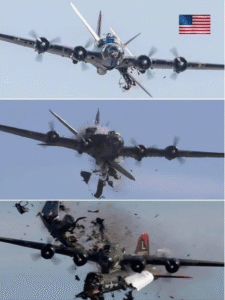Remembering the Dallas Air Show Mid-Air Collision: Honoring Aviation Heritage and Lessons for the Future
The roar of engines, the smell of aviation fuel, and the excitement of thousands of spectators gather each year to celebrate the thrill of flight. Air shows have long held a special place in American culture, blending the spectacle of aerobatics with a deep respect for the history and technology of aviation. Yet, amidst the excitement, the Dallas Air Show mid-air collision stands as a sobering reminder of the risks inherent in aviation and the responsibility that comes with it. As we reflect on this tragic event, it is vital to honor those affected while learning lessons that can guide the future of air shows and aviation safety.
The Event: A Celebration Marred by Tragedy
The Dallas Air Show, an annual gathering that attracts aviation enthusiasts from across the country, is designed to thrill and inspire. Spectators line the tarmac, cameras in hand, as vintage warbirds, modern fighter jets, and aerobatic performers execute daring maneuvers overhead.
On that fateful day, two aircraft—performing a carefully choreographed routine—collided in mid-air. Eyewitnesses recall the sudden shock as metal met metal, followed by an eerie silence and a cloud of smoke rising above the tarmac. Emergency services acted quickly, but the incident claimed the lives of the pilots involved. The immediate aftermath left the air show community and local residents stunned, turning what should have been a celebration of aviation into a moment of collective grief.
Honoring Aviation Heritage
Despite the tragedy, it is essential to remember the broader context of air shows and the pilots who risk their lives to entertain and educate the public. Air shows are not only displays of skill; they are living lessons in aviation history. From the P-51 Mustangs of World War II to the modern F-35 fighters, each plane represents decades of engineering ingenuity, national pride, and the evolution of flight.
Veteran pilots often stress that performing at an air show is a way to honor the heritage of aviation. These routines are rehearsed extensively to ensure safety while demonstrating the incredible capabilities of each aircraft. The Dallas Air Show collision, while tragic, does not diminish the contributions of these pilots but instead highlights the courage and expertise required to perform complex aerial maneuvers.
Lessons in Safety
Mid-air collisions, though rare, underscore the importance of rigorous safety protocols. Aviation authorities and air show organizers continuously analyze such incidents to prevent future tragedies. Key lessons from the Dallas collision include:
-
Enhanced Communication: Pilots performing coordinated maneuvers must maintain constant, clear communication. Even minor misinterpretations can lead to catastrophic outcomes.
-
Rehearsal and Spatial Awareness: Pilots should engage in extensive ground-based simulations and air rehearsals to perfect timing and spacing. Understanding each aircraft’s flight envelope is critical.
-
Emergency Response Preparedness: Quick and effective emergency response saves lives. The Dallas incident highlighted the professionalism of local first responders, who acted promptly despite the chaotic environment.
-
Continuous Evaluation: Post-incident investigations provide invaluable data. Reviewing flight paths, mechanical logs, and pilot decisions informs future air show regulations and training programs.
These lessons have already influenced how air shows are conducted nationwide. Organizers now implement stricter separation rules, improved communication systems, and enhanced pilot certification requirements, all aimed at reducing the likelihood of mid-air collisions.
The Human Element
While technical considerations are vital, the Dallas collision also serves as a reminder of the human element in aviation. Pilots dedicate their lives to mastering the skies, balancing precision, courage, and split-second decision-making. Each pilot involved in the incident had years of experience, yet even the most skilled aviators face unpredictable factors such as wind gusts, mechanical anomalies, or brief lapses in timing.
Families of the pilots and first responders affected by the collision have spoken of resilience, support, and the strength of the aviation community. Vigils and memorials were held to honor those lost, demonstrating the deep bonds among pilots, enthusiasts, and communities who share a passion for flight.
The Broader Impact on the Aviation Community
The Dallas Air Show collision sparked discussions across the aviation world about the balance between spectacle and safety. Experts in aerospace engineering, flight safety, and pilot training have emphasized the need for continuous innovation in both technology and procedures. For example, advancements in collision avoidance systems, real-time telemetry, and high-visibility markings on aircraft are now increasingly incorporated into air show performances.
Moreover, the incident has reinforced the importance of public education. Spectators are encouraged to understand the risks and respect safety boundaries, appreciating the skill and bravery of pilots without compromising their own well-being. The goal is to create an environment where awe-inspiring performances can continue safely, preserving the cultural and educational value of air shows.
Moving Forward: Remembering While Innovating
Honoring the memory of the pilots and lessons learned from the Dallas collision involves a delicate balance of remembrance and forward-thinking. Annual tributes, scholarships for young pilots, and safety workshops have been established in the wake of the incident. These initiatives ensure that the tragedy contributes to the education and protection of future aviators.
Air shows continue to be a vital part of aviation culture, bridging generations and inspiring interest in aerospace careers. Each performance—whether by a vintage biplane, a modern jet, or an aerobatic team—serves as a testament to human ingenuity and the enduring fascination with flight. By integrating lessons learned from past incidents, organizers can honor the legacy of pilots while safeguarding the future of air show entertainment.
Conclusion
The Dallas Air Show mid-air collision remains a sobering chapter in the history of American aviation. It reminds us of both the fragility and the brilliance of flight. While the event claimed lives and shocked spectators, it also highlighted the courage, dedication, and professionalism of those who take to the skies.
Honoring the victims involves more than mourning—it requires a commitment to learning and improving. Through enhanced safety measures, continued pilot training, and public awareness, the aviation community ensures that the spirit of air shows endures.
Ultimately, air shows are celebrations of human achievement, technical mastery, and the thrill of flight. By remembering the Dallas collision, we pay tribute to those who risk everything to keep the legacy of aviation alive, ensuring that future generations can experience the wonder of flight safely and responsibly.
The roar of engines and the awe of spectators will continue to define air shows, but with each tribute and each safety innovation, the aviation community honors its heroes, learns from its past, and looks confidently to the future.


